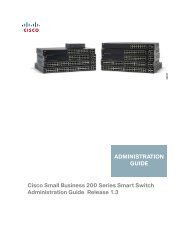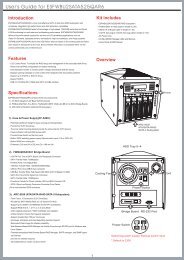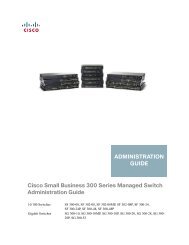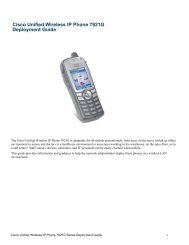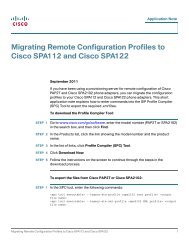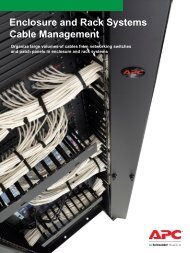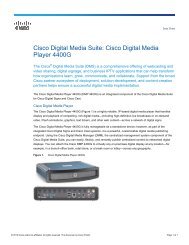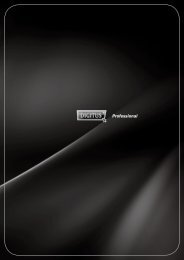NETWORK TECHNOLOGY - SWS a.s.
NETWORK TECHNOLOGY - SWS a.s.
NETWORK TECHNOLOGY - SWS a.s.
You also want an ePaper? Increase the reach of your titles
YUMPU automatically turns print PDFs into web optimized ePapers that Google loves.
Structured Cabling<br />
The length of the fixed cable between the jack and the patch panel is set at a<br />
maximum of 90m here.<br />
The maximum distance in the Permanent Link can also be shorter, since a<br />
consolidation point integrated into the cabling runs also has effects on the<br />
technical transmission values of the laid cable. Patch cables between jack<br />
and end device should not exceed a maximum length of 20 m: the length<br />
of patch cable used in the patch field at the floor sub-distribution cable<br />
has a maximum length of 5 m. Consolidation points which are used should<br />
be placed at least 15 m from the floor sub-distribution panel since plug-in<br />
connections used in the immediate vicinity can exert influences on various<br />
transmission parameters. The types of cable used in cabling on floors consist<br />
of 100 Ohm 4 paired twisted pair cables and 50/125μ multi-mode glass fiber<br />
cables.<br />
The maximum cable length of the transmission run should be 2000m for the<br />
site and building cabling of the secondary area. The previously mentioned<br />
cable types are also preferred here. The often larger distances between<br />
buildings also offer an area of use for 07/15μ mono-mode glass fiber cable.<br />
Connection technology for structured cabling<br />
The cable which has been used for laying can be described with the following,<br />
different characteristics.<br />
• Copper conductor consisting of solid copper for permanent<br />
installation between sub-distribution panels on floors and<br />
between distribution panels and jacks.<br />
• Copper conductor as flexible conductor wire for use in the<br />
manufacture of patch cables.<br />
• Details of the diameter and/or cross section in mm, mm2 or<br />
AWG (American Wire Gauge). The larger the wire diameter,<br />
the smaller the attenuation.<br />
This section shows the following examples:<br />
AWG 24/1 = conductor consisting of solid wire with 0.511 mm<br />
conductor diameter<br />
AWG 26/7 = conductor consists of 7 wires with 0.48 mm<br />
conductor diameter<br />
• Strands are twisted into pairs and provided with a colour code<br />
in the conductor insulation. The colour code is done according<br />
to EIA/TIA 568 / IEC 708-1 with the wiring:<br />
Pair 1 = wire 1 in white/blue, wire 2 in blue<br />
Pair 2 = wire 1 in white / orange, wire 2 in orange<br />
Pair 3 = wire 1 in white / green, wire 2 in green<br />
Pair 4 = wire 1 in white / brown, wire 2 in brown<br />
• The screening is used to improve transmission safety. In<br />
accordance with the valid standard, it guarantees the limita<br />
tion of electromagnetic disturbances and also the immunity of<br />
the network against disturbances.<br />
• External cladding consisting of PVC or a halogen-free, fame<br />
resistant compound.<br />
Halogen-free = no corrosive, or clearly less toxic gases and<br />
very low quantities of smoke<br />
Flame resistant = self extinguishing after removal of the heat<br />
source, very limited propagation of fire<br />
FR<br />
LS<br />
NC<br />
OH, ZH<br />
= flame retardant<br />
= low smoke<br />
= no corrosive fumes<br />
= no halogen<br />
The requirements for the patch panels and jacks are defined in DIN EN<br />
50173-1. These products are divided into various classes in accordance with<br />
the performance class. Optimisation of the products allows panels and jacks<br />
to satisfy the requirements when a gigabit Ethernet is being operated. These<br />
have been set down in the standards DIN EN 50173-1:2000 with both types,<br />
category 3 up to 16 MHz and category 5 up to 100 MHz and also in EIN EN<br />
50173:2002 with the types, category5 up to 100 MHz, category 6 up to 250<br />
MHz and category 7 up to 600 MHz. The designation, category 5E which is<br />
generally used on the market corresponds to category 5 in accordance with<br />
DIN EN 50173-1:2000.<br />
All the category 5 products certified according to standard can be used<br />
independently from their manufacturers in so-called „Mix & Match" systems.<br />
They are combined into a class D connection in the installation which has<br />
been created.<br />
Class E products are characterized by the fact that each manufacturer has<br />
optimized his articles for his products with 250 MHz in order to satisfy the<br />
requirements of class E.<br />
All the products are clearly defined and only „work" with each other according<br />
to certification. This means that „Mix & Match" is not possible. These<br />
products also do not comply with category 6 in accordance with DIN EN<br />
50173-1:2002.<br />
Category 6 products according to the new standard are only products which<br />
have been tested according to „De-Embedded Testing". This makes sure that<br />
the advantages reached by technical and mechanical improvements are used.<br />
Each category 6 jack with a RJ45 plug produces a category 6 connection<br />
according to standard.<br />
„De-Embedded-Testing" - Logo<br />
U/UTP<br />
F/UTP<br />
SF/UTP<br />
S/FTP<br />
completely unscreened, paired unscreened,<br />
twisted cable<br />
completely foil screened, paired unscreened, twisted<br />
cable<br />
cable completely screened with foil and braid, paired<br />
unscreened, twisted cable<br />
cable completely screened with braid, paired foil<br />
screened twisted cable<br />
88





